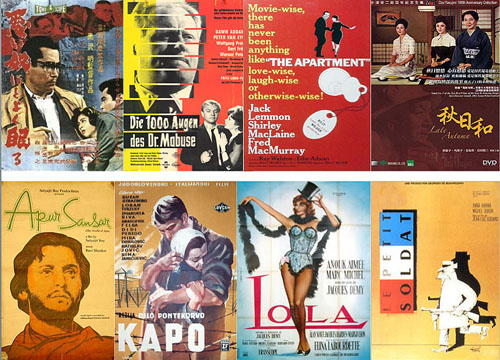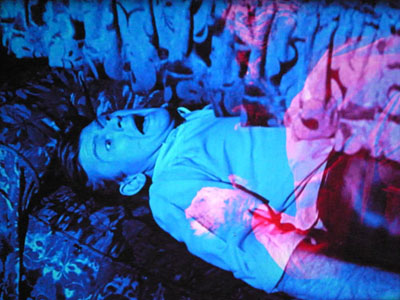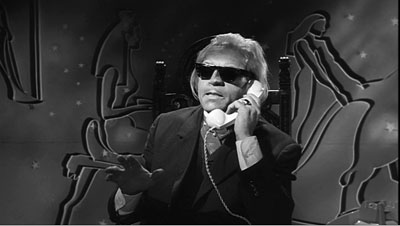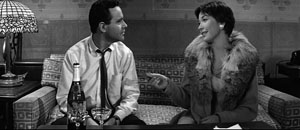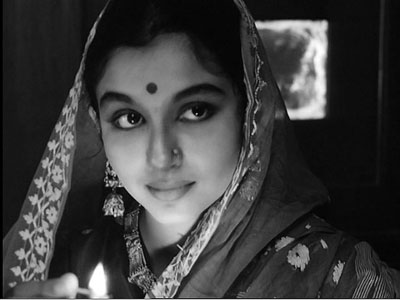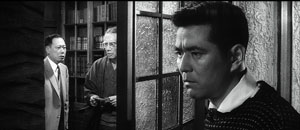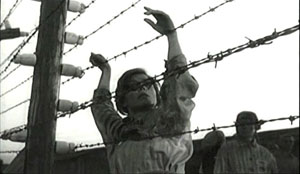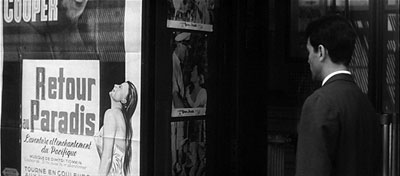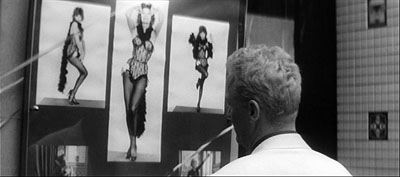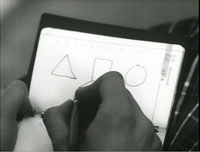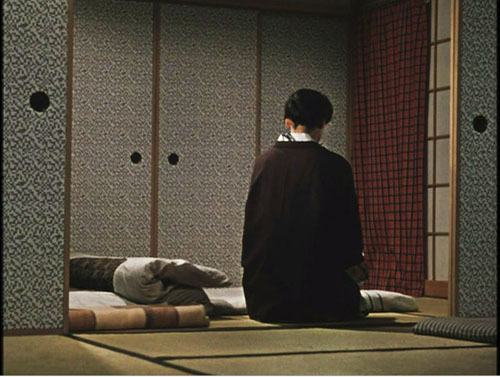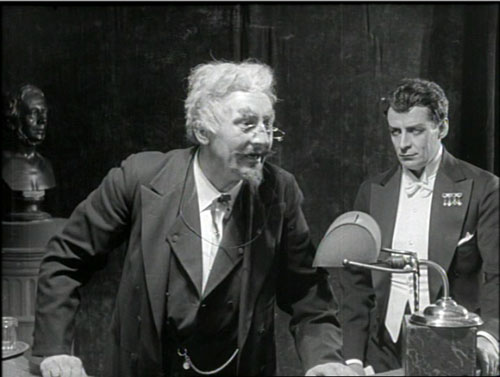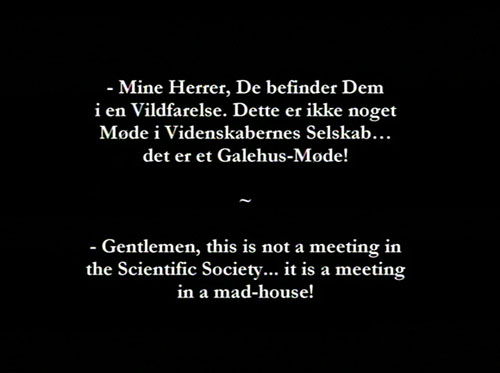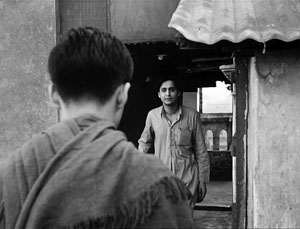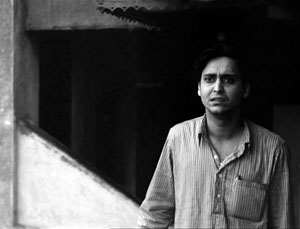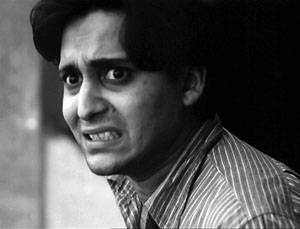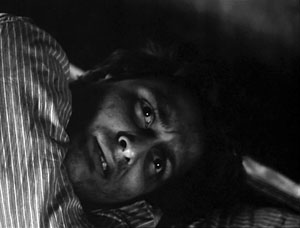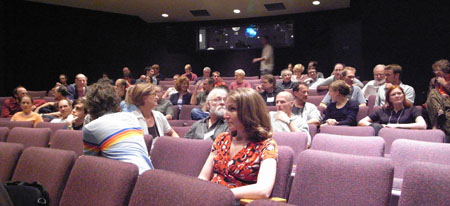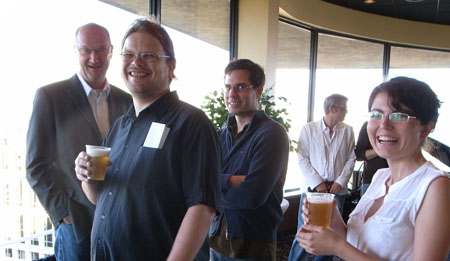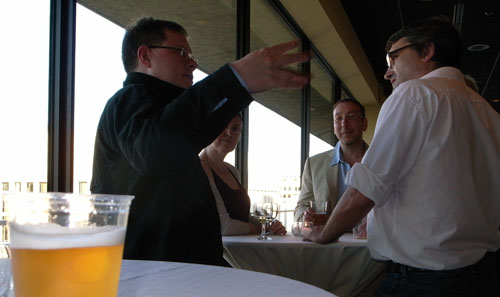Archive for the 'Directors: Ray, Satyajit' Category
Class of 1960
DB here:
By now most people accept the idea that 1939 was a kind of Golden Year of cinema. You know, Rules of the Game, Stagecoach, Wizard of Oz, that movie about the Civil War, etc. TCM has even made a movie about 1939. On this site Kristin and I have talked about earlier wonder years, like 1913 and 1917. So in planning this year’s Bruges week-long Zomerfilmcollege (aka Cinephile Summer Camp), Stef Franck and I discussed building my lectures around a single year. I proposed 1941, but he countered with 1960.
1960 was a logical choice in providing spread for the whole program. At Bruges we intertwine several threads of lectures and screenings, and this year we had silent films (The Cat and the Canary, The Wind), Hollywood’s cinema of emigration (Florey, Siodmak, Ophuls, etc.), and contemporary Korean film. All in 35mm, of course. So picking 1960 filled in another area.
As so often happens, a contingent choice came to seem a necessary one. By the time I opened my mouth to introduce The Bad Sleep Well, I had convinced myself that 1960 was another watershed year. Consider these releases:
Rocco and His Brothers (Visconti), La Dolce Vita (Fellini), L’Avventura (Antonioni), Le Testament d’Orphée (Cocteau), Plein Soleil (Clement), À bout de souffle (Godard), Les Bonnes femmes (Chabrol), La Verité (Clouzot), The Bridge (Wicki), Wild Strawberries (Bergman), The Devil’s Eye (Bergman), Lady with the Little Dog (Heifetz), The Letter that Wasn’t Sent (Kalatozov), The Steamroller and the Violin (Tarkovsky short), The Teutonic Knights (Alexander Ford), Innocent Sorcerors (Wajda), Saturday Night and Sunday Morning (Reisz), Tunes of Glory (Neame), Sergeant Rutledge (John Ford), Psycho (Hitchcock), Spartacus (Kubrick), Elmer Gantry (Brooks), 101 Dalmatians (Disney/ Reitherman), The Magnificent Seven (Sturges), Exodus (Preminger), Home from the Hill (Minnelli), Comanche Station (Boetticher), Verboten! (Fuller), The Bellboy (Lewis), The Young One (Buñuel), TheYoung Ones (Alcoriza), The Shadow of the Caudillo (Bracho), Devi (Ray), The Cloud-Capped Star (Ghatak), This Country Where the Ganges Flows (Karmakar), Red Detachment of Women (Xie Jin), The Back Door (Li Han-hsiang), Enchanting Shadow (Li Han-hsiang), The Wild, Wild Rose (Wang Tian-lin), Desperado Outpost (Okamoto), Spring Dreams (Kinoshita), When a Woman Ascends the Stairs (Naruse), Daughter, Wives, and Mother (Naruse), Cruel Story of Youth (Oshima), The Sun’s Burial (Oshima), Night and Fog in Japan (Oshima), The Island (Shindo), Pigs and Battleships (Imamura), Sleep of the Beast (Suzuki), and Fighting Delinquents (Suzuki).
We didn’t show any of them.
Several factors constrained our choices, including the availability of good prints with Dutch subtitles, or at least English ones. We also didn’t want to run too many official classics. And we fudged a little for pedagogy’s sake. We had to include a Godard, but instead of À bout de souffle, we picked Le Petit soldat—made in 1960 but not released until 1963. The World of Apu was released in 1959 in India, though it made its world impact in the following year. Lola was finished in 1960 but released in early 1961. A dodge, but I wanted a Nouvelle Vague counterpoint to Godard, and it fit well with the Ophuls thread, and—well, it’s Demy. In any case, we wound up with a list of outstanding movies.
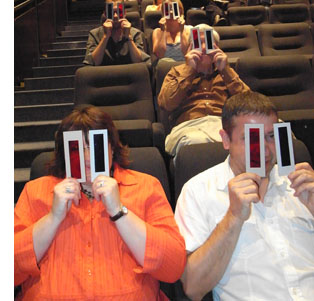 Running alongside my titles were horror films and thrillers from the same year, including Peeping Tom, Black Sunday, The Leech Woman, and Corman’s House of Usher. William Castle’s 13 Ghosts was shown with reconstructed versions of the original two-color Ghost Viewers. (Look through red if you believe in ghosts, blue if you don’t.) Imagine the shot above through a red filter. The creature, pink on the print, turns satanically crimson—confirmation that ghosts exist, although they look less like Casper and more like those Red Devil candies you ate in theatres as a kid. In a prologue, available here, Mr. Castle explains it all.
Running alongside my titles were horror films and thrillers from the same year, including Peeping Tom, Black Sunday, The Leech Woman, and Corman’s House of Usher. William Castle’s 13 Ghosts was shown with reconstructed versions of the original two-color Ghost Viewers. (Look through red if you believe in ghosts, blue if you don’t.) Imagine the shot above through a red filter. The creature, pink on the print, turns satanically crimson—confirmation that ghosts exist, although they look less like Casper and more like those Red Devil candies you ate in theatres as a kid. In a prologue, available here, Mr. Castle explains it all.
All in all, quite a week. My sessions ran from 9:00 AM to 12:30 or 1:00 PM, with the film embedded. After lunch, there were more talks and screenings, usually winding up at about 1:00 AM. Other speakers included Kevin Brownlow, Tom Paulus, Steven Jacobs, Muriel Andrin, Egbert Barten, and Christophe Verbiest (linking his talks on contemporary Korean film to the absolutely nuts 1960 Kim Ki-yong melodrama The Maid). The locals’ lectures were in Dutch, but these worthies are fluent in English, so sharing meals with them allowed me to catch up with their ideas.
Pegging a batch of movies to a single year can seem gimmicky, so I treated the films as exemplifying different trends, many of which started before 1960 and have continued since. I concentrated on trends within world film culture, though in several cases those were tied to still broader social and political developments. Above all, the 1960 frame allowed me to do the sort of comparative work I enjoy.
Generations
My first grouping was “Twilight of the Masters.” This allowed me to develop the idea that, remarkably, people who had started making films in the 1910s and 1920s were still active in the 1960s—and often making films that recalled their youthful efforts. Renoir revisited La Grande illusion in The Elusive Corporal, and Dreyer returned to his origins in tableau cinema through the staging of Gertrud.
In this connection, Fritz Lang’s 1000 Eyes of Dr. Mabuse, his final movie, revisits his Mabuse cycle in the way his previous films for Artur Brauner revise the “sensation-films” he wrote for Joe May (especially The Indian Tomb). Drawing on some ideas in my online essay, “The Hook,” we studied Lang’s crisp transitions between scenes. From this angle, 1000 Eyes is a sort of encyclopedia of ways you can connect scenes (visual link, auditory link, association of ideas, etc.). The transitions whip up a breathless pace and steer past some plot holes, and sometimes they generate a level of mistrust, implying story possibilities that don’t turn out to be valid.
Testament’s motif of eyes and vision became expanded to television surveillance in 1000 Eyes. There might even be an oblique connection between the Hotel Luxor’s panopticon and the rise of television ownership in Europe at the period. Here, as ever, cinema doesn’t have good things to say about TV.
Twilight of another, not quite so old master: Late Autumn by Ozu. I reviewed some features of Ozu’s style and then analyzed the film as a multiple-character drama. Ozu and his collaborator Noda Kogo split up the plot in order to present different characters’ attitudes to the central situation: the question of a daughter’s marriage. The plot ingeniously withholds information about the attitude of Akiko, the mother, by deleting certain scenes that would clarify it. Here too, the old master recalls earlier films by having characters discuss their college flirtations, which invoke scenes from Days of Youth and Where Now Are the Dreams of Youth?
Both Billy Wilder and Akira Kurosawa furnished me with a second generational cohort. I know, probably nobody in his right mind would see common features between these two directors. But desperation can fuel audacity. Both emerged during the late 1930s, began directing in the 1940s, and enjoyed a string of great successes in the 1950s; but both fell on harder times in the 1960s. Both became accusatory living legends, haunting local industries that had kept them from working.
Leading up to The Apartment, I considered Wilder’s contribution to two trends. First, the industry had hit the doldrums. In Europe television and new leisure lifestyles were not yet the threat they would become, but in America, the industry needed to pull its audience away from the TV set and the barbecue. Wilder proved skilful in using Hollywood’s turn to sex as the basis for his cynical comedies. The Lubitsch touch, a worldly appreciation of the oblique approach to matters of sex, was replaced by something harsher. In Wilder’s world, there are mostly sharks and shnooks, those who take and those who are taken.
Second, I situated Wilder as a leading figure in the emergence of the writer-turned-director in the 1940s (Sturges, Huston, Brooks, Fuller, Mankiewicz, etc.). This encouraged me to probe his dramaturgy, and so we analyzed the taut structure of The Apartment’s plot. It has rightly been recognized as a model screenplay, making us sympathize with a careerist covering up his bosses’ infidelities, all the while whetting our interest by shifting the range of knowledge away from the protagonist at key moments. It also displays a nice interweaving of motifs that function both dramatically and metaphorically (especially Miss Kubelik’s hand mirror). Of course at the end I had to run a clip showing the influence of The Apartment on the opening of Jerry Maguire.
By the mid-1960s, however, Wilder was pushing his luck, especially with Kiss Me Stupid. In The Apartment he wanted to make “a movie about fucking,” and he predicted that some day people would do the deed onscreen. But having glimpsed the promised land of the 1970s, he was unable to enter. Despite some worthy efforts, notably The Private Life of Sherlock Holmes, he haunted Hollywood as a major director who had outlived his moment.
Human, all too human
Kurosawa’s international fame came largely through the growth of the film festival as a prime institution of international movie culture. This situation let me sketch in the importance of festivals in bringing directors like him to world recognition. (By the way, Richard Porton has just brought out an informative collection of thoughts on film festivals.) With The Bad Sleep Well, I was able to talk a bit about something that is often forgotten—Kurosawa’s efforts in social, even political cinema. From Sugata Sanshiro, a tribute to Japanese martial arts, and The Most Beautiful, the loveliest movie you’ll ever see about girls making lenses for gunsights, up through Occupation projects like No Regrets for Our Youth and Scandal, Kurosawa engaged with political subject matter. Ikiru and I Live in Fear made this side of his work even more salient in the 1950s.
The Bad Sleep Well’s attack on corporate corruption sits well with this tendency. It considers the “iron triangle” of Japanese politics, the collusion of bureaucrats, politicians, and private industry—particularly the building industry, whose livelihood depends on bids for government projects. Still, it’s hard to believe that while Kurosawa made the film, and while Ozu made the serene Late Autumn, students were fighting police in the streets over the US-Japan security treaty. That turmoil surfaced in Oshima Nagisa’s demanding and formally daring Night and Fog in Japan.
The movie is shot with Kurosawa’s usual muscularity, including virtuoso compositions in what he called, following Toland, “pan-focus.”
The film’s twists also seemed to me worth examining. The protagonist is a minor presence in the first scenes, and his reticence in the beginning is mirrored in the finale, when he simply vanishes and his pal has to tell us what happened to him. Such a daring structure, reminiscent of the abrupt midway break in Ikiru, gives the film an almost Brechtian discomfiture, as well as highlighting the secondary characters’ rather perverse reaction to the hero’s fate.
Kurosawa was widely called a “humanist” director, and this concept sheds light on what we might call the “international film ideology” pervading festivals in the 1950s. In various areas of social and philosophical thought, a notion of humanism emerged out of disillusionment with the “age of ideology” that had engulfed the world in war. Several thinkers declared that the age of religious dogma and social collectivism, either Nazi or Communist, was over. Now what mattered were the features that drew people of all societies together, and the prospect of enlightened social action based on those commonalities—tolerance, respect, and a belief that people ultimately took individual responsibility for their communities. Catholics, Communists, and people of all stripes scrambled to call themselves humanists. As Dwight Macdonald, former Trotskyite, put it, “The root is man.”
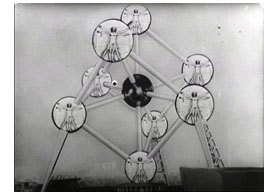 This frame of reference can be seen in Steichen’s 1955 photo exhibition, circulated around the world in a best-selling book, called The Family of Man, as well as in the 1958 Brussels Expo, the first major world’s fair since the war. There films like For a More Human World (frame right) presented technology, science, education, and cooperation as teaming up to improve the lives of people in all nations.
This frame of reference can be seen in Steichen’s 1955 photo exhibition, circulated around the world in a best-selling book, called The Family of Man, as well as in the 1958 Brussels Expo, the first major world’s fair since the war. There films like For a More Human World (frame right) presented technology, science, education, and cooperation as teaming up to improve the lives of people in all nations.
Film festivals embraced this universalism, pointing to the great films of Italy’s Neorealist trend as proof of cross-cultural communication. Although these films often scored specifically Italian political points, they could also be seen as human documents speaking to audiences anywhere. Who could not empathize with Ricci and his son in Bicycle Thieves (named at the 1958 Expo as the third-greatest film ever made)?
The turn to humanism helps answer a puzzling question: Why Satyajit Ray? Virtually no Europeans had ever seen a film from India. What enabled a director from this country to achieve worldwide renown? And why not other Indian directors of his era, such as Raj Kapoor, Guru Dutt, Mrinal Sen, and Ritwik Ghatak? All of these had to wait many years for discovery by European tastemakers.
For one thing, Ray was highly westernized himself. He was a child of the Bengali Renaissance, a virtuoso in many fields (he composed music, drew with facility, wrote detective stories and children’s books), and an admirer of European cinema. A stint assisting Jean Renoir exposed him to one of the greatest of Western filmmakers. A viewing of The Bicycle Thieves determined him to make films. He was skeptical of imitating Hollywood, which had been a prime inspiration for Hindu cinema. He criticized Bollywood’s reliance on schematic romance and musical numbers. If any Indian director was to make the move to the festival circuit, it would be him. (You can argue that other non-European filmmakers who made it into the fold were the most “western”—Kurosawa, Leopoldo Torre Nilsson, etc.).
Just as important, Ray’s stories suited the humanist program. Whereas Ghatak and Sen made politically charged films, Ray concentrated on the individual. In The World of Apu, social conditions are shown, but as a background to the development of personality and psychological tensions. At the film’s start, students are holding a street march demanding political rights, but they are offscreen, a backdrop to Apu’s meeting with his old professor as he gets his letter of recommendation. What follows is a drama of artistic failure, blossoming love, and a young man’s confused growth to maturity and responsibility.
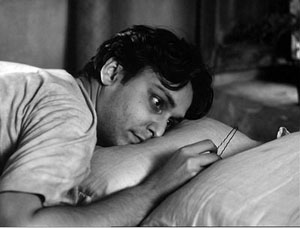
It’s a simple story, rendered lyrical through constantly developing imagery: Apu stretched out prone, the famous grimy window curtain, and a cluster of visual motifs I hadn’t noticed on previous viewing. Ray’s concise direction links the torn curtain in Apu’s room to the famous (Langian?) transition from a movie screen to a carriage window, the cluster unified by associating Apurna with male children. Thanks to Andrew Robinson’s book on Ray, we know that in the carriage scene she is already thinking of the son she will bear.
It’s easy to romanticize this handsome, happy-go-lucky hero. I think the College participants thought I was a little hard on Apu, since I treated him as far from the “conscientious and diligent” young man his professor wrote of. Surely his idealistic-novelist persona is sympathetic. But if he is to grow as the film suggests, he must have failings, and Ray shows them to us—dreamy indolence, self-centeredness, even poutiness. The film is a character study, a sort of Bildungsroman tracing how Apu learns his place in his world. Our discussion after this film was particularly rich, with one participant suggesting that in accepting his son he isn’t abandoning his art entirely, but giving it human significance: He promises to tell Kajal stories.
Ray came to directing in middle age, a somewhat rare option. So too did Gillo Pontecorvo, but the latter made many fewer films. Although Kapò, isn’t as strong a movie as our other entries, it did allow us to talk a bit about coproduction, about European cinema’s relation to World War II, and about what came to be known as the morality of technique.
European coproductions are another fundamental part of the 1960 landscape, and they illustrate how economic considerations penetrate artistic choices. (Why are American and Italian actors in the “German” film 1000 Eyes of Dr. Mabuse? Why do we find Anouk Aimée in 8 ½ and Jeanne Moreau in La Notte? Follow the money.) For the Italian production Kapò, the primary roles are taken by an American (Susan Strasberg, playing the heroine Edith) and two French actors—the concentration camp translator played by Emmanuelle Riva and the heroic Soviet soldier played by Laurent Terzieff. The film was shot in Yugoslavia.
The story centers on a young Jewish girl who, in order to survive Nazi internment, passes herself off as a Gentile and becomes a camp commandant, whipping other prisoners into line. Other Italian films of the period, notably Rossellini’s Generale Della Rovere, were dealing with issues of conscience during the war, but Kapò was apparently the first fictional feature in Western Europe to confront the Holocaust since Alessandrini’s Wandering Jew of 1947. In 1960, Adolf Eichmann had been captured by the Mossod and stood trial the following year, and after Kapò came a few other films addressing the camps, notably Wajda’s Samson (1961) and Lumet’s The Pawnbroker (1965). So the film had a strong contemporary resonance; after its US release, it would be nominated for an Oscar.
One reason Stef and I picked Kapò was the controversy around Jacques Rivette’s accusation in Cahiers du cinéma that for a particular tracking shot Pontecorvo deserved “the most profound contempt.” The film, as Rivette indicates, is dominated by an already compromised conception of realism: grimed faces, make-up that hollows cheeks, somewhat ragged clothes, moderately shabby bunks. The shot shows the body of Theresa hurled against the electrified barbed wire, with the camera coasting slowly toward it. Her silhouette is almost classically composed, with the hands artfully pivoted and standing out against the sky. For Rivette this pictorial conceit is virtually obscene.
It seems to me that Rivette’s essay sought in part to reply to those who thought that Cahiers’ policy amounted to pure formalism. In calling for an ethics of technique, Rivette argues that artistic choices which might seem to be in the service of correct politics can betray a deeper immorality: using a historical cataclysm as an occasion for a safe realism and self-congratulatory flourishes. Similar complaints could be lodged against Kramer’s Judgment at Nuremberg and Stone’s World Trade Center. And because for the Cahiers team artistic cinema was an expression of a creator’s vision, the morally maladroit traveling shot brands the director as a man of bad faith.
Rivette isn’t saying that film artists shouldn’t try to represent historical trauma. He simply argues that other paths could be taken. For instance, Resnais’ Night and Fog and Hiroshima mon amour acknowledge that some events cannot be encompassed by normal understanding, and the form of each film enacts an effort to understand, not a fixed conclusion. What we see in Night and Fog is “a lucid consciousness, somewhat impersonal, that is unable to accept or understand or admit this phenomenon.” For Rivette, Pontecorvo seems convinced that romantic love and self-sacrifice can overcome Nazism, albeit with some help from the Red Army. He tries to explain, even prettify, an event that cannot be understood within the usual humanistic categories.
New Wave, still new
Lola.
Godard’s Le Petit soldat is far more preoccupied with uncertainties, even confusions, than Kapò is. 1960 saw an extraordinary number of former colonies, especially in Africa, gain independence, and during that year the Algerian war of resistance was spreading to Europe. Godard’s central character Bruno is working with the OAS vigilantes dedicated to killing Algerian terrorists, but when he meets the lovely Veronica Dreyer he decides to leave politics behind and flee with her to Brazil. Perhaps “decides” is the wrong word, since his actions are impulsive: he abruptly shies away from committing a political assassination, and he abruptly abandons his colleagues. But he’s captured by FLN terrorists and, in the film’s most famous sequences, tortured. At the end, he commits the assassination, not knowing that Veronica, herself in league with the Algerians, has been captured by his pals and killed. But his final voice-over is almost a shrug, and his act of murder takes on the flavor of an existentialist acte gratuite.
Le Petit soldat doesn’t offer heroic figures, as Kapò does in Theresa and the Soviet soldier. Nor does it allow us to sympathize much with the egotistical, capricious Bruno. The texture is more disjunctive, littered with the usual digressions and citations. Since the film was shot in Geneva, there’s a persistent motif of Swissness, with citations of Paul Klee. A sneaky one I never noticed before: the seduction game Bruno plays is modeled on the three fundamental shapes in the Bauhaus basic course, which Klee taught.
Having experimented with discontinuous imagery in À bout de souffle, Godard in his second feature turns his attention to the soundtrack, creating one of the most minimalist ones I know. If Bresson whittles down his soundtrack to a spare but recognizable realism, Le Petit soldat goes a step further, scrubbing out nearly every noise until we’re almost watching a silent film. Traffic scenes lack traffic noises, with only a car horn or a bit of dialogue breaking in. One passage on a train could almost be a sound loop.
The strategy of suppressed sound is carried to a paroxysm in the torture scenes, with the clink of handcuffs and the soft tapping of typewriter keys highlighted and bits of music played spasmodically…but no sounds of pain. Only during the rushed and almost throwaway climax, is something like a plausible city ambience heard. In a dichotomy that will be familiar throughout Godard’s work, there’s a split between image (Bruno is a photographer, and in the early part of the film he takes snapshots of Veronica in her apartment) and sound (the political factions rely on telephones and tape recorders, and the OAS thugs trick their way into Veronica’s apartment through sound recording).
In all, Le Petit soldat isn’t exactly fun but it’s exhilarating in its bursts and unexpected frictions. Next time somebody tells me that Godard’s technical innovations have all become commonplace, I’ll point to this film of 1960, which would be daring and demanding if released tomorrow.
Fun, albeit grave, is what Lola is all about. It takes formal artifice far beyond realism, creating a sort of non-musical musical. (It has one number, and even that is a sketchy rehearsal.) As geometrical as a minuet, its plot plays out in a hall of mirrors, where characters share names, pasts, and sentiments. The sailor Frankie and the wandering Michel, both in love with Lola, are blonde giants. Lola is actually named Cécile, and the little girl of the same name seems in some ways an early version of her, while Cécile’s mother has a dash of Lola in her past.
Roland starts out as the protagonist, but as he warms and cools and warms to Lola, the story momentum shifts to others. There’s Lola of course, and young Cécile who strikes up a friendship with Frankie, and Cécile’s mother who yearns a bit for Roland, and Michel, who left Nantes years ago and has lived in another movie, specifically, Mark Robson’s Return to Paradise (1952). Here the structure of the plot unfolds the network of relationships among people, linked mostly by casual encounters across a few days. The last section accordingly consists of a series of farewells, as if the story can end only by breaking ties of affection.
In surveying these films, I was struck by how much most of them owed to the growth of postwar institutions of film culture, and how strong those institutions remain. Coproductions and subsidies were feeding a massive buildup of European cinema. Contrary to what you might expect, as attendance cratered from the late 1950s onward, the number of European films produced went up. The EU countries still overproduce, releasing nearly 1200 theatrical features in 2008.
Film festivals were promoting not only universal humanism; they were also packaging films under rubrics of authorship or the New XXX Cinema and the Young ZZZ Cinema. 1940s Neorealism, aka “New Realism in Italian Cinema,” seems to have been, once more, the prototype. Festivals must make discoveries and emphasize novelties. At the same period film schools taught professional standards, and film archives showed classics and gave postwar filmmakers a more secure sense of the medium’s history. Lang, Ozu, and Wilder weren’t dependent on such institutions, but younger filmmakers were. And still are.
1960 is an arbitrary data point, but it stands out as an extraordinary year for quality. In addition, picking it as a benchmark allowed me to think about some important trends of the period. What probably didn’t show through my lumbering PowerPoints, with their charts, diagrams, and frame enlargements, was how much I learned from my Bruges stay. One of the deep satisfactions of teaching is remembering, no matter how confidently you declare your claims, how much more there is to know. Of things cinematic there is no end.
We also asked participants to read Serge Daney’s essay, “The Tracking Shot in Kapò.” Daney’s elaborate exercise in autobiography, irony, and moral reflection could not be plumbed in the time at my disposal, there or here. But it did help me understand Rivette’s argument. In preparing my lectures, I also owed a debt to some excellent books, notably Tom Gunning, The Films of Fritz Lang: Allegories of Vision and Modernity; Andrew Robinson, Satyajit Ray: The Inner Eye; Carlo Celli, Gillo Pontecorvo: From Resistance to Terrorism; and Richard Brody, Everything Is Cinema: The Working Life of Jean-Luc Godard. As ever, the invaluable documentation provided by the print editions of Screen Digest over the years enabled me to compile my tables of attendance, releases, and the like.
Late Autumn.
P.S. 3 Aug: Stef has posted snapshots from our Zomerfilmcollege here.
P.P.S. 3 Aug: This helpful correction from Roland-François Lack on Le Petit Soldat:
One small point: the organisation Bruno works for cannot be the O.A.S., which wasn’t active until the end of 1960.
He is working, rather, for ‘La main rouge’, a government sponsored counter-terrorist agency run by a Colonel Mercier (hence the name of Bruno’s associate).
Nice! Thanks.
Invasion of the Brainiacs II
DB here:
What gives movies the power to arouse emotions in audiences? How is it that films can convey abstract meanings, or trigger visceral responses? How is it that viewers can follow even fairly complex stories on the screen?
General questions like this fall into the domain of film theory. It’s an area of inquiry that divides people. Some filmmakers consider it beside the point, or simply an intellectual game, or a destructive urge to dissect what is best left mysterious. Many readers consider it academic bluffing, another proof of Shaw’s aphorism that all professions are conspiracies against the laity.
These complaints aren’t quite fair. Early film theorists like Hugo Münsterberg, Rudolf Arnheim, André Bazin, and Lev Kuleshov wrote clearly and often gracefully. Even Sergei Eisenstein, probably the most obscure of the major pre-1960 theorists, can be read with comparative ease. Moreover, generations of filmmakers have been influenced by these theorists; indeed, some of these writers, like Kuleshov and Eisenstein, were filmmakers themselves.
But those day are gone, someone may say. Does contemporary film theory, bred in the hothouse of universities and fertilized by High Theory in the humanities, have any relevance to filmmakers and ordinary viewers? I think that at least one theoretical trend does, if readers are willing to follow an argument pitched beyond comments on this or that movie.
That is, film theory isn’t film criticism. Its major aim is more general and systematic. A theoretical book or essay tries to answer a question about the nature, functions, and uses of cinema—perhaps not all cinema, but at least a large stretch of it, say documentary or mainstream fiction or animation or a national film output. Particular films come into the argument as examples or bodies of evidence for more general points.
In about three weeks, about fifty people will gather at the University of Copenhagen to do some film theory together. It’s the annual meeting of the Society for Cognitive Studies of the Moving Image. I talked about the group last year (here and here) in the runup to our Madison event.
The sort of theorizing we’ll do, for all its variety, is in my view the most exciting and promising on the horizon just now. It’s also understandable by anyone interested in puzzles of cinematic expression, and it has powerful implications for creative media practice.
We’ll also be in Copenhagen for Midsummer Night, which is always pleasant. Go here for the lovely song that thousands of Danes will try to sing, despite terminal drunkenness. No real witches burned, however.
Concordance and convergence
But back to topic: Puzzles of cinematic expression, I said. What puzzles? Well, films are understood. Remarkably often, they achieve effects that their creators aimed for. Michael Moore gets his message across; Judd Apatow makes us laugh; a Hitchcock thriller keeps us in suspense. What enables movies to reliably achieve such regularity of response?
It’s not enough to say: Moore hammers home his points, Apatow creates funny situations, Hitchcock puts the woman in danger. Any useful explanation subsumes a single case to a more general law or tendency. So a worthwhile explanation for these cinematic experiences would appeal to more basic features of artworks, cultural activities, or our minds. We can pick up on Moore’s message because we know how to make inferences within certain contexts. We can laugh at a joke because we understand the tacit rules of humor. We recognize a suspenseful situation because… well, there are several suggestions.
This sort of question is largely overlooked by theorists of Cultural Studies, another area of contemporary media studies. They typically emphasize difference and divergence, highlighting the varying, even conflicting ways that audiences or critics interpret a film.
Studying how viewers appropriate a film differently is an important enterprise, but so is studying convergence. Arguably, studying convergence has priority, since the splits and variations often emerge against a background of common reactions. A libertarian can interpret Die Hard as a paean to individual initiative, while a neo-Marxist can interpret it as a skirmish in the class war, but both agree that John and Holly love each other, that her coworker is a weasel, and that in the end John McClane’s defeat of Hans Gruber counts as worthwhile. Both viewers may feel a surge of satisfaction when McClane, told by a terrorist he should have shot sooner, blasts the man and adds, “Thanks for the advice.” What enables two ideologically opposed viewers to agree on so much?
Films aren’t just understood in common; they arouse remarkably similar emotions across cultures. This is a truism, but it’s been too often sidestepped by post-1960 film theory. Who, watching The World of Apu, doesn’t feel sympathy and pity for the hero when he learns of the sudden death of his beloved wife? Perhaps we even register a measure of his despair in the face of this brutal turn of events.
We can follow a suite of emotions flitting across Apu’s face. I doubt that words are adequate to capture them.
Are these facial expressions signs that we read, like the instructions printed on a prescription bottle? Surely something deeper is involved in responding to them—for want of a better word, fellow-feeling. Indians’ marriage customs and attitudes toward death may be quite different from those of viewers in other countries, but that fact doesn’t suppress a burst of spontaneous sympathy toward the film’s hero. We are different, but we also share a lot.
The puzzle of convergence was put on the agenda quite explicitly by theorists of semiotics. Back in the 1960s, they argued that film consisted of more or less arbitrary signs and codes. Christian Metz, the most prominent semiotician, was partly concerned with how codes are “read” in concert by many viewers. Today, I suppose, most proponents of Cultural Studies subscribe to some version of the codes idea, but now the concept is used to emphasize incompatibilities. So many codes are in play, each one inflected by aspects of identity (gender, race, class, ethnicity, etc.), that commonality of response is rare or not worth examining.
A complete theoretical account, if we ever have one, would presumably have to reckon with both differences and regularities. The dynamic of convergence and divergence is a central part of one arena of film studies that has, for better or worse, been called cognitivism.
Sampling
Gathering for Uri Hasson‘s keynote lecture, SCSMI 2008.
The cognitive approach to media remains a pretty broad one, and the Society for Cognitive Studies of the Moving Image hosts a plurality of approaches at its annual meetings. SCSMI has become home to media aesthetes, empirical researchers, and philosophers in the analytic tradition who are interested in interrogating the concepts used by the other two groups. Last year’s gathering, at our campus here in Madison, created a lively dialogue among these interests.
For instance, some of us Film Studies geeks wonder why people so consistently ignore mismatched cuts. Dan Levin’s ingenious experiments on “change blindness” provide a hilarious rejoinder. In one study conducted with Dan Simons, a stooge asks directions of an innocent passerby. As they’re talking, a pair of bravos carry a plank between them, and another confederate is substituted for the first one.
You guessed it. Most subjects don’t notice that the person they’re talking to has changed into somebody else! So how can we worry about mismatched details in cuts? Actually, Dan’s research isn’t just deflationary. It helps spell out particular conditions under which change blindness can occur.
Another stimulating talk was offered by Jason Mittell. He asked how long-running prime-time TV serials can solve the problem of memory. In this week’s episode what strategies are available to recall the most relevant action of earlier episodes? How can previous action be presented without boring faithful fans? Jason, who has a new book on American TV and culture out this spring, went beyond describing the strategies. He suggested how they can become a new source of formal innovation, as in the Death of the Week in Six Feet Under.
Sermin Ildirar of Istanbul University presented the results of a study on adults living in a village in South Turkey. These viewers were older, ca. 50-75, and—here’s the interesting part—had never seen films or TV shows. To what extent would they understand “film grammar,” the conventions of continuity editing and point-of-view, that people with greater media experience grasp intuitively? To facilitate comprehension, the researchers made film clips featuring familiar surroundings.
The results were intriguingly mixed. Some techniques, such as shots that overlapped space, were understood as presenting coherent locales. But most viewers didn’t grasp shot/ reverse-shot combinations as a social exchange. They simply saw the person in each shot as an isolated figure.
The discussion, as you may expect, was lively, concerning the extent to which a story situation had been present, the need to cue a conversation, and the like. I found it a sharp, provocative piece of research. Stephan Schwan, who worked with Sermin and Markus Huff, has become a central figure studying how the basic conventions of cutting and framing might be built up on the basis of real-world knowledge, and both he and Sermin are back at SCSMI this year.
Stephan Schwan, Thomas Schick, Markus Huff, and Sermin Ildirar, with Johannes Riis in the background; SCSMI 2008.
There were plenty of other stimulating papers: Tim Smith’s usual enlightening work on points of attention within the frame, Johannes Riis on agency and characterization, Paisley Livingston on what can count as fictional in a film, Patrick Keating on implications for emotion of alternative theories of screenplay structure, Margarethe Bruun Vaage on fiction and empathy, and on and on.
One of the best things about this gathering was that the ideas were sharply defined and presented in vivid, concrete prose. I can’t imagine that ordinary film fans wouldn’t have found something to enjoy, and of course many of these matters lie at the heart of what filmmakers are trying to achieve. Indeed, some filmmakers regularly give papers at our conventions. The much-sought link between theory and practice is being made, again and again, in the arena of the SCSMI.
Last year I came to believe that this research program was hitting its stride. My hunch is confirmed by this year’s gathering in Copenhagen. The department of media studies there has long been a leader in this realm. You can download a Word version of the schedule here.
Lest you think that the conference participants don’t talk much about particular movies, I should add that there’s one film we’ll definitely be talking about this time around. Our Copenhagen hosts have arranged for a screening of von Trier’s Antichrist.
Next time: Going deeper into cognitivism, and three recent explorations.
Malcolm Turvey makes a point to Trevor Ponech and Richard Allen, SCSMI 2008.
Kristin and I have talked about pictorial universals elsewhere on this site. See her blog entry on eyeline matching in ancient Egyptian art, and my comments on “representational relativism” here.
Images at the top of this entry are taken from the Danish film Himmelskibet (The Space Ship, aka A Trip to Mars, 1918).












